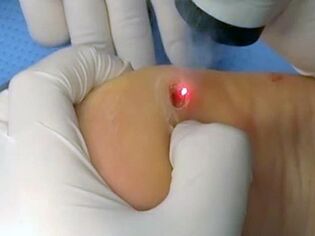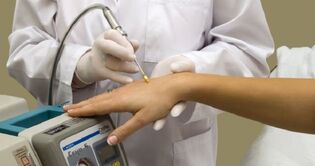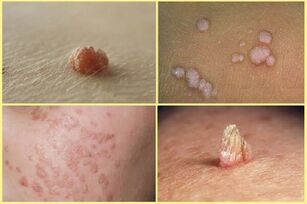Warts are formations on the skin and mucous membranes of a benign nature, which occur as a result of activation of the human papillomavirus.
They are not aesthetic and often cause complexes. A person wants to get rid of it, but does not know how.

Should we remove the accumulation?
It depends on the size of the papillomas, their nature and the age of the person. But more often than not, the answer is unequivocally positive, because warts are contagious and can be transmitted to others. Maybe self-infection is also self-vaccination.
First, the infectivity of neoplasms is manifested not only in direct contact with them, but also when using common household items, personal hygiene items or simplyby touching places where an infected person has touched them. For example, a bus handrail.
Second, the location of the wart may be in a place that is most likely to be injured - the neck, feet, armpits, groin. These places are more often than others rubbed with clothes, squeezed and touched. Then it is loaded with malignancy, bleeding, proliferation.
Third, the formations can increase in size and number, which causes aesthetic problems. This phenomenon can be called the conquest of territory by a wart.
Important! Not always, but maybe the degeneration of a wart into melanoma, an aggressive, incurable skin cancer.
Main misconceptions about the danger of surgery
Early treatment and treatment of warts is the best option. It will save you a lot of time, effort and money. If 70% of warts can disappear spontaneously after 2 years of existence, they can come back with the same success and, moreover, to new places.
The fears of many when coming into contact with the surgeon are associated with fear of the operation, its complications, relapses and possible pain during the procedure. They are completely unfounded, as modern methods provide very good pain relief and many do not require anesthesia.

There is still a widely held opinion that an extra touch of wart with a surgeon's knife will increase its growth. This is the deepest misconception - it is the surgery that will prevent the spread of the virus and stop the wart from growing. Fortunately, there are enough methods for this.
Strange can be called the patients who are not afraid to use local traditional methods and refuse skilled help. The experience and qualifications of a doctor are, of course, crucial, but a good surgeon is not uncommon.
And one more help - do not rely on cosmetologists and run to them with warts. They just don't have enough medical training.
Modern methods
There are newer or older removal methods. Each of them has its own advantages and disadvantages. In addition, the effect depends on the size of the wart, its position and the depth of growth.
All methods can be grouped into 3 groups: material, surgical and chemical. Alternative treatment is more related to the method of physical (mechanical) impact.
When contacting the doctor, the doctor may recommend the best option in their opinion, but the last choice is made by the patient himself.
A prior consultation is also necessary as not all the methods you have chosen are suitable, as there are contraindications and limitations.
Laser treatment
The laser method can be called universal. Among all the methods, he is in the lead today. With the help of a laser, you can remove warts in the most difficult, delicate and painful places. It is also advantageous in that it does not give scars. The beam is the safest and the least traumatic.

The efficiency is so high that one procedure is enough. The essence of the thermal effect on the wart burns with temperature. Healing is rapid, without scars or complications.
More laser benefits:
- the patient is not in pain;
- no anesthesia required;
- complete removal;
- fast - takes 1 to 2 minutes. Relapses are only possible in 20% of cases.
Burning leaves a pit that heals in 2 weeks. The skin may lighten temporarily, which also goes away on its own after 3 weeks.
Cauterization with liquid nitrogen
Cryodestruction is the freezing of a wart by the method of low temperatures with liquid nitrogen. Duration - 30 seconds. Freezing results in the death of the growing tissue. When exposed to freezing, the papilloma thickens and turns white. After a minute, it turns red and swells.
A gray liquid bubble will appear in your home. In a week, it will break through on its own and a scab will form. The crust heals and falls off within 2 weeks.
A pinkish spot remains, gradually its color will become equal to the skin. The formation will disappear within 2 weeks and a pinkish spot appears at the site of removal, which gradually disappears.

Benefits:
- no pain, no scar and no anesthesia required;
- no infection or bleeding.
The only downside is that there is no way to control the depth of the impact.
On the soles of the feet, the impact lasts about 1 minute. The procedure can be repeated on the sole up to 5 times. Less - long healing.
Electrocoagulation
Electrocoagulation for warts uses high frequency currents. It concentrates in a loop that cuts the wart. The moxibustion temperature is around 80 degrees.
No bleeding due to simultaneous clotting of blood vessels. Local anesthesia is necessary. A big advantage of the method is that it prevents the virus from spreading further. In addition, the method is quite budgetary and efficient.
The surrounding tissue should be covered and the skin should be disinfected. There is also a crusting step. It disappears in a week. After that, an almost imperceptible transparent scar remains, but most often a bright spot. There is no relapse!
Application of radio wave therapy
The method is considered to be no less efficient than electric current. Moxibustion is done using special devices; a doctor will help you choose the right one. This is a radio wave generator, its high frequency electric waves do not touch the wart, but cut it off completely.

The essence of the action is that the wart cells contain fluid, which expands with radio waves, the wart swells and bursts. The work is done with a special tip resembling a ballpoint pen.
There are no scars or infections. The only downside is the pain of the procedure, because of this the build-up is pre-lubricated with an anesthetic. Healthy cells are not damaged. Moxibustion lasts about 20 minutes.
Tip! At the crust stage, it cannot be wet and peeled! She disappears in a week.
Surgical excision
Surgical removal is a traditional and classic method performed with a scalpel. It is not often used now. The method is traumatic and gives relapses and scars.
There is a risk of damage to adjacent tissue, the possibility of infection. But it is irreplaceable if the wart is large. Under local anesthesia with a special spoon, after the incision, the wart is scraped off. The seams are cosmetic, they are removed in a week. The scar remains around 3mm and fades over time.
Chemical moxibustion
The formation is subjected to action with an acid or an alkali. After a while, wash off. There are usually at least 6 procedures to achieve the effect. There is a burning or stinging sensation during this. The wart dries up and falls off.

Disadvantages:
- there is a risk of the virus spreading and infection is not excluded;
- healthy tissue is often damaged;
- scars are possible, healing takes about 10 days.
The method is only used if other methods are not possible.
Advantages and disadvantages of the different methods, which is the best
Any method of removal has its pros and cons, there are no ideal options. Today, the most popular methods are: laser therapy, cryotherapy, electrocoagulation, radio waves, a surgical scalpel - in descending order of frequency of use. The cost of the first 3 methods is actually in the same price range.
The laser is the first to steer: there are no places it cannot reach, it is safe, fast and painless. Cryodestruction is considered the second most effective, but with it there is no possibility of controlling the depth of exposure, which leads to relapses.
And one more conclusion: the laser can only remove a small formation in 1 session.
Cryotherapy is applicable for papillomatosis, when up to 40 growths can be removed in 1 procedure. But here the experience of the doctor is of great importance for the quality.
How does the location and type of growth affect the choice of technique?

There are 4 types of warts:
- vulgar- in the form of small nodules, often grow on the fingers and toes, the backs of the hands;
- dishes- typical for adolescents, they are presented in the form of highlights; these include the plantar (thorns);
- filiform (skin tags) - thin elastic growths on the leg, appear on the face (eyelids, lips) and neck;
- genital warts - often localized on the mucous membrane of the genitals; resemble cauliflower in appearance.
These 4 types are viral and belong to real warts.
But there are also senile keratomas, which are caused by functional disorders of the skin. They do not require treatment, only observation. Cryotherapy can be used if desired.
The doctor recommends a method of elimination, but ultimately the patient chooses. How the choice of method depends on the type of wart: Small formations can be safely removed with aradio wave "knife", or liquid nitrogen.
Radio Knifeis applicable on the face and neck, feet and palms, groin. With papillomas on the eyelids, it is not used. They can use a laser or liquid nitrogen.
Gelis also used on the arms and feet (on the sole), papillomas on the neck. The cryo method can be called universal. It's certain.
Laser- removes all warts on any part of the body, including under the nail.
Thesurgical methodis used for large growths on the lining of the mouth.
electrocoagulation is recommended for flat and common warts. Can even be applied to the face. With large formations, the effect is negligible. Also, the electric knife is not used for plantar warts, as they usually have deep roots and they are very dense.
Important! It is advisable to remove plantar growths only in a hospital.
The chemical method gives good results in plantar, flat and pointed lesions. Physical methods are ineffective in comparison with him.
What method of disposal of formations do doctors recommend?
The customer chooses, of course, according to his abilities. But he must be guided by the doctor's opinion to make the right decision. Specialists prefer the complex (combined) treatment of warts, where the first place belongs to the removal.
In addition, treatment will include oral administration of drugs with antiviral activity. Although the HPV virus (human papillomavirus) is not 100% cured and its activation depends in many ways on the state of immunity, it can be slowed down, "sleepy" and remission can be prolonged.
In addition to antivirals, immunomodulators are used for this purpose. It is, first of all, a group of interferons.
Doctors treat traditional methods without much enthusiasm, as the treatment is not performed by doctors and will not be safe. It is fraught with damage to surrounding tissues, infection, inflammation. Children under 5 should not remove warts under any circumstances.














































































